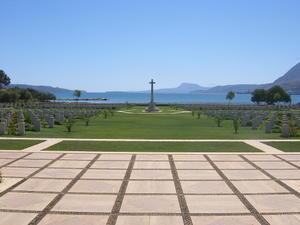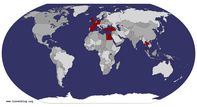Advertisement
Published: August 10th 2006

 Suda Bay Commonwealth War Cemetary
Suda Bay Commonwealth War Cemetary
It is beautifully maintained and occupies a secluded corner of Suda Bay.Todays blog is going to be quite different from the usual travel updates as it summarises my trip and experience in visiting the battlefields and war cemetaries of the Battle of Crete. It will involve a bit of a historical context to begin with and will probably be quite long, so perhaps you could find time to read it later. I think I will start with explaining just what went on during the battle, as it is an inspiring story that I think all New Zealanders should be aware of and pay their respects to.
First the historical context. In April 1941 the Germans were on a roll and had invaded Greece and their battle-hardened and superbly equipped army pushed a much inferior Allied force, including the NZ Division, out of mainland Greece. The survivors withdrew to Crete, having to leave most of their heavy equipment behind, and began preparations to defend the island from the imminent German invasion. By nature of its position in the middle of the Eastern Mediterranean, Crete was a strategically important island that had airfields which dominated the major shipping lanes to North Africa and the Suez Canal, so the Germans were very keen to
capture it. However as they couldn't invade Crete from the sea they decided to launch an airborne invasion with their elite paratroop units.
Crete was defended by only 28,000 Commonwealth troops who had survived evacuation from Greece. The NZ Division was concentrated on the western side of the island around Hania and Maleme, where they were tasked with defending the vitally important airfield. Assisting them were the local Cretan population who proved to be fierce fighters, even though a lot of them were only armed with pitchforks, clubs and knives.
On 20 May 1941 the German airborne assault began as the air above Maleme airfield was filled with thousands of German paratroopers. The NZ defenders were short of ammunition and heavy weapons, but they each had a rifle and they fought ferociously. Most of the first wave of Germans fell on the NZ positions around the airfield and the fighting was vicious and often hand to hand with bayonets. Casualties were huge on both sides and the Germans were forced to reconsider whether the island was worth the huge human price they were paying. Nevertheless the Kiwis held out around Maleme for three days even though the Germans

 The rows of fallen Kiwis
The rows of fallen Kiwis
As you look at this picture, all of the headstones heading back to the hedge is the NZ section, although many others are mixed in with the British and Australians.dropped wave after wave of paratroopers around them. Eventually the better equipped and more numerous Germans proved to great a force and Maleme airfield was taken.
With the airfield in German hands they began to fly in plane after plane of elite reinforcements and heavy equipment that ultimately proved the difference. The decision was then made to evacuate Crete from the southern coast and the Commonwealth soldiers, including Brits and Aussies who had been fighting further east, retreated south through a mountain pass. Again the NZ troops came to the fore forming a rearguard that stopped the German advance and allowed the Allied soldiers to evacuate south. One moving account I read details how the 28th Maori Battalion terrorised the Germans by performing hakas and charging their lines with bayonets. The Germans were stunned by the hakas and the ferocity of their Maori assault and they withdrew, allowing the retreating soldiers more time to head south. About 16,000 troops were evacuated to Egypt, with the remainder were hidden by the local population or were captured. Of the 7700 Kiwis who fought on Crete, approx 700 died, 1000 were wounded and another 2000 were made captured. More information is available

 Laura beside her grandfather's grave
Laura beside her grandfather's grave
S.Sgt K Whetton, Royal Army Medical Corps.through this excellent website:
Battle of Crete.
This brings me to yesterday which was a very moving and inspiring day as I traced the paths of the NZ soldiers. First of all I visited the Commonwealth War Cemetary at Suda Bay and saw the row upon row of fallen NZ soldiers who died on Crete. What struck me was the number of NZ soldiers who lie there, with Kiwis seeming to make up about a third of all the gravestones, despite there being far more Australians and Brits fighting on Crete. Clearly we bore the brunt of most of the fighting and many paid the ultimate price. 446 NZ soldiers were buried there and many more are probably elsewhere in unmarked graves. That doesn't count the number of graves that are marked simply "A soldier of the 1939-1945 War", as the remains had been unidentifiable. The cemetary is immaculately looked after and it inhabits a quiet and secluded spot on the corner of Suda Bay.
While I was there I met an English girl called Laura who was visiting her grandfathers grave. Her story is a moving one and she said it was ok for me to tell it. Her

 The grave of a 26 year old NZ soldier
The grave of a 26 year old NZ soldier
He was my age when he died which certainly put everything in to perspective.grandparents married two weeks before her grandfather was sent to Crete in the Royal Army Medical Corps. He died on the first day of the invasion, leaving behind his new bride back in England, who unbeknown to them was pregnant with a baby girl who went on to become Laura's Mum. He died not knowing that he was to become a father. Laura was on her own quest to find his gravesite so we decided to head back to Hania together and we had some lunch before she left for Heraklion.
Then I went to Maleme which these days is a luxury beach resort 20 km west of Hania. The airfield is still there and these days is a small commercial airport for light planes. On top of Hill 107, which was the high ground above the airfield where the heaviest fighting took place, there is a German cemetary to commemorate their dead, and again it is moving to walk amongst their graves. I don't blame the Germans for what they did as they were just following orders and fighting for their country as the NZ soldiers were. The paratroopers weren't ardent Nazi fanatics like other units and from

 German War Cemetary at Hill 107
German War Cemetary at Hill 107
The graves of the German paratroopers are marked by plaques laid out in a bed of red flowers.what I read they treated the NZ POWs with respect. A plaque told a story about a German mother who had three of her four sons jump over Crete in the same Parachute Regiment (the youngest was thankfully too young). All three of them were in the first wave and were dead by the time the first day had finished. So they have their own stories to tell too.
My grandfather Ian Thomas was in the NZ Division and his battalion formed the rearguard which stemmed the German advance in Greece and allowed the beaches to be evacuated. As his unit was pretty badly beaten up as they left Greece, they were on Crete for only a short time before being redeployed to Egypt to recuperate and reinforce the British line against the German Afrika Corps under Rommel. Nevertheless Poppa lost some good mates on Crete and he would be glad to know that I am here paying my respects.
To conclude I encourage anyone, whether you be a New Zealander or not, to come to Crete and see what I have seen. If you base yourself in Hania then the major sites are all within 20 km.

 View towards Maleme Airfield from Hill 107
View towards Maleme Airfield from Hill 107
This gives you some perspective of the terrain they were fighting over, with the airfiel runway visible behind the trees. The blue sky in the background would have been black with planes and falling paratroopers.To get to Suda Bay War Cemetary ignore the instructions in Lonely Planet as they are misleading. Instead simply catch a taxi (the trip back to Hania was only about 7 euro) and they can take you straight there and even wait if you like. To get to Malame get a ticket from the central bus station and travel west for about 25 mins. Maleme is the first village after Platanias, but if you tell the driver where you are going he will drop you off at the turn off. The road to Hill 107 is signposted in German with a cemetary icon and is very close to the Louis Creta Princess Resort on the main road. The bus trip was about 4 euro return and buses go west every half hour.
Apart from Gallipoli, Crete was the most dramatic battle that the NZ soldiers have participated in and they fought against the odds and did themselves proud, as did the Brits and Australians they fought alongside. They signed up in huge numbers to go to the other side of the world to fight someone else's fight in someone else's country, and many of them still lie here.

 The grave of a 26 year old German soldier
The grave of a 26 year old German soldier
Again he was my age but the German cemetary has many soldiers who were barely out of their teens.I came across this poem which was written by either a New Zealander or an Australian soldier (the plaque said ANZAC soldier) and I thought that it was a fitting way to sign this entry off.
On a mountainous little island
By the shores of Suda Bay,
Are the dead of many ANZACs
Buried where they lay,
Their deaths the deaths that
Only gallant soldiers die.
On that little island
With peaks all capped in snow,
Its grove of olive trees
And grapevines row by row.
From the ocean wreathed in white caps
To the mountains wreathed the same,
Are the fields they fought so bravely
Those who carry the ANZAC name.
We, who were there, remember
Those days of hell on Crete,
And hope that when our time comes
Old pals again we'll meet.
As we trudge along the road
Of life that's left to be,
Mates again for eternity
With those who sleep 'neath the olive trees.
Advertisement
Tot: 0.103s; Tpl: 0.011s; cc: 12; qc: 52; dbt: 0.0539s; 1; m:domysql w:travelblog (10.17.0.13); sld: 1;
; mem: 1.2mb













Craig Holden
non-member comment
respect
Excellent account Ben, respect....